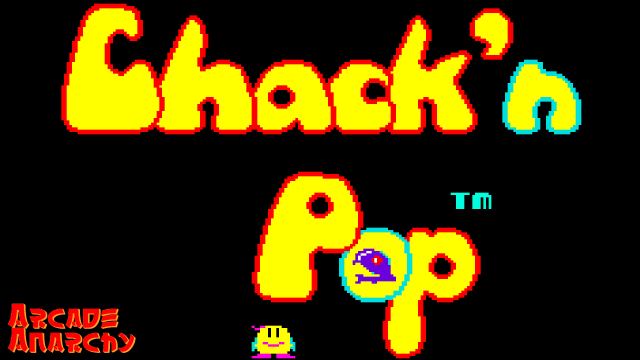
Welcome to a series of Arcade Anarchy, where we explode different arcade games ranging from the awesome, awful and awkward.
When it comes to arcade games, Taito has historically been one of the more significant during the golden era of arcade games. You might be familiar with a number of Taito’s catalog, including games like Space Invaders, Arkanoid, Darius, and Bubble Bobble. But if you’ve played through Taito’s many arcade games or the ports on many different consoles and home computers, you might of encountered a strange yellow creature with pink legs and blue wings at some
This creature is called Chack’n. But what exactly is a Chack’n, and why does the developers at Taito seem to have a fondness for it? Well, Chack’n is the main character of the 1983 arcade game Chack’n Pop. Technically speaking, he’s referred to as Mr. Chack’n, with his girlfriend also appearing in this referred to as Mrs. Chack’n. It’s also the debut of several recurring enemies of the Bubble Bobble series, such as Monsta and Maita, and also Zen-chans that went unused but were re-purposed for Bubble Bobble.
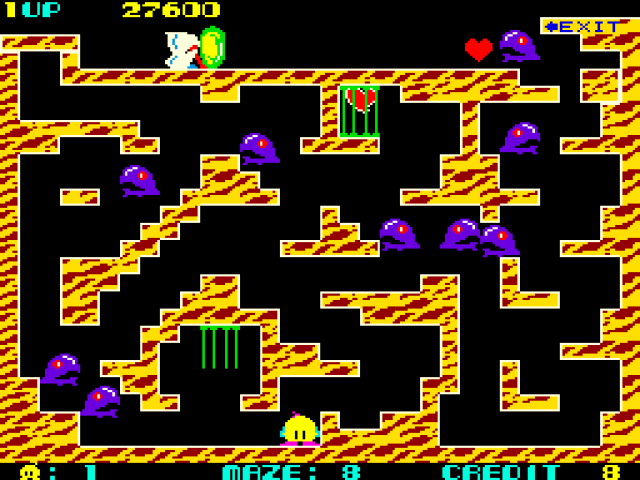
Chack’n Pop was originally developed on Taito’s Z80 CPU based arcade board, which powered other games such as The Legend of Kage and Return of The Invaders. The exact developers that developed this video game is ambiguous, as the original arcade game doesn’t provide credits. However hidden it’s code refers to a programmer called JUN, and Yoshino Imamura who has worked on the production of games such as The Ninja Warriors and Super Chase H.Q. has previously worked on Chack’n Pop, supposedly providing the music. The identity of JUN isn’t known, as a similar alias is hidden in Bubble Bobble, and it possibly isn’t Yoshino Imamura as they are theorized to go under the alias “OTO”.
Chack’n Pop overall has a very bare presentation, with only a single screen at a time and no backrounds, making it similar to earlier arcade games like Donkey Kong or Pac-Man. Though in this case it’s more of an optimization choice, as the hardware itself as shown in games like Pit & Run was capable of showing backgrounds. As Chack’n Pop was designed in a way to have dozens of enemies flood the screen at a time and to make them clearly visible, it was important for the game to sacrifice detail for performance. This development trick was similarly used for the later released Bubble Bobble, to allow a lot of bubbles to flood the screen without sacrificing performance.
The premise of the game is simple. You play as Mr. Chack’n, as you are tasked with finding the hearts that the Monstas and Maitas have stolen and locked them up in mazes. As you enter each stage, you’ll be given a maze layout with eggs and caged hearts. These eggs will eventually hatch into Monstas, but luckily you can destroy the eggs before they get the chance to hatch. While Monstas and Maitas do appear, in reality the Monstas are your only foe. Maitas instead reside at the top of the screen and act like a time limit; if they manage to reach the right side of the screen, you’ll lose a life.
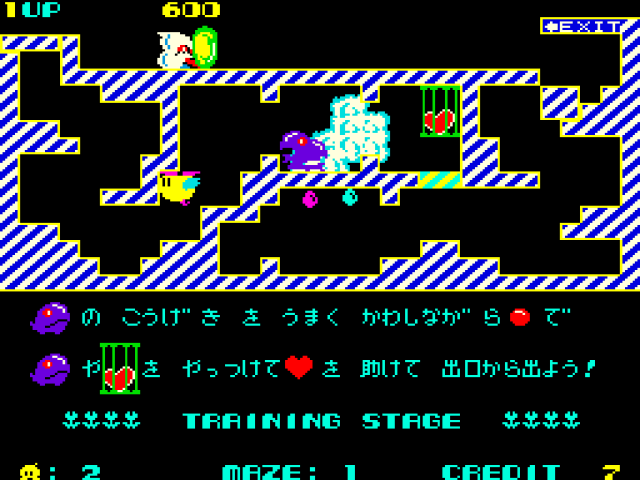
There are 15 stages total in the game, a “training stage” and 14 regular stages. The training stage is unique because you’ll progress to the next level regardless of if you reach the exit or not. The only problem is that the training stage doesn’t teach you about how the water mechanics work, such as the ability to swim or how the water heavily weakens the blast radius of your bombs. The other stages though all share the same goal of releasing the hearts and reaching the exit before it’s sealed off by the Maitas. While on the surface it’s a simple task, the game with each maze will try to mix it up with different gimmicks like breakable walls or water balloons that flood the maze. Later stages will also possibly swamp the maze with Monstas, as the game will punish you by adding more Monstas to the next stage if you ignored them in the previous one.
The main challenge of the game isn’t the maze layout, but rather the unusual control layout. Chack’n is incapable of jumping, instead in order to traverse the maze you’ll need to stick to the floors and ceilings. By holding up on the joystick, Chack’n will stretch up by two tiles, automatically attaching himself to any ceiling above him and allows him to move up a ledge that is at least two tiles tall. Though Chack’n will automatically climb up steps. Another weird quirk is that Chack’n will always move forward, which can be slightly annoying in situations where you have to walk across small platforms. The key rule to remember is that while Chack’n can walk on the ground or ceiling, he cannot walk on walls, and strangely can’t cling to the ceiling if he’s handing on an edge.
Your only method of attacking is tossing out bombs. One button will toss a bomb to the left and another will toss the bomb to the right, regardless of which way Chack’n faces. The bombs themselves takes about 3 seconds to detonate, and in the meanwhile you can’t toss another bomb until the one on-screen detonates. This means that in order to kill the Monstas, you’ll need to time the bombs in advance. The most important thing to remember is that these bombs can also hurt Chack’n, and with the way the mazes are structured, there will be several cases where you’ll accidentally blow yourself up. However, if you time your explosions right and kill a lot of Monstas at the same time, you may be rewarded with a Super Heart that temporarily turns Chack’n invisible and moves faster than normal.
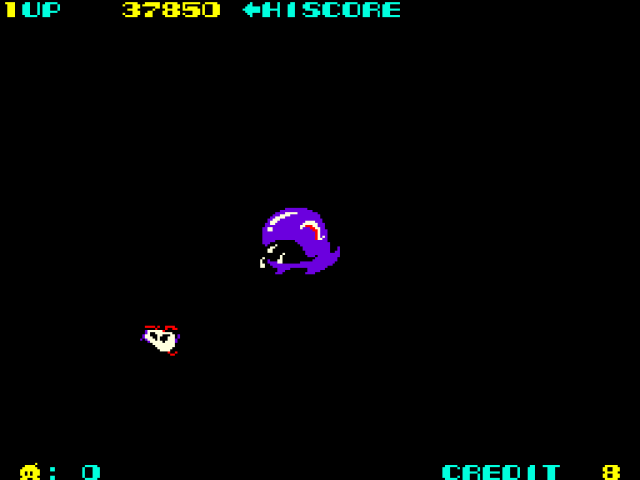
It’s magically delicious~♪
Strangely, despite the common comparison to Bubble Bobble, Chack’n Pop overall feels more comparable to Pac-Man, such as you playing as a yellow creature, exploring a maze while avoiding monsters that vaguely resemble ghosts, and you being forced to move forward. There are even cutscenes between some stages that shows Chack’n fighting against the Monstas and Maitas, like how Pac-Man treats cutscenes. This includes one where Chack’n jumps on a group of Maita, and one where he gets eaten by a giant Monsta and disturbingly gets his skeleton spat out. The random fruit you can get from blowing up multiple Monstas is even called “Bonus Fruit”.
The biggest weakness of Chack’n Pop is the overall restrictive nature. Between the inability to jump, the maze-like structure, and the situational nature of the bombs, it is very easy to get overwhelmed by the enemies. The behavior of the Monstas combined with the sheer number of them in later mazes means there will be a lot of times where you’ll be forced to waste time trying to clear out an opening, or simply die due to not having enough time to detonate the bombs. Remember, you’re on a time limit too, so you still need to move. On top of that, the game is punishing with credits; Even if you insert additional credits into the machine, you’ll still be forced to play from the beginning.
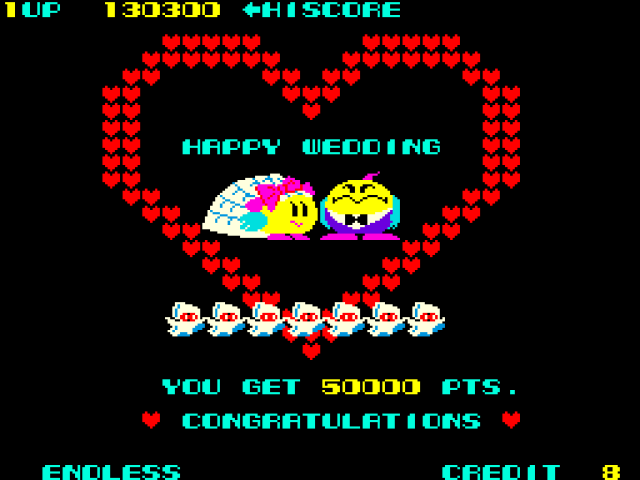
But once you clear through every stage, you’ll see the heartwarming scene of Mr. Chack’n officially marry Ms. Chack’n. How sweet.
Chack’n Pop would later receive a few ports, including the Famicom and SG-1000. The general premise of the game between each port is retained, but also have their own characteristics. The Famicom version for example has only 9 of the original stages on an endless loop and a lot less enemies appear on the screen at a given time. The SG-1000 version reprogrammed by SEGA has a unique song instead of the repetitive beat of the original and is also generally easier due to the timing of the bombs being slightly faster and the Monstas being slower.
Chack’n Pop itself would in the long run have an odd legacy. The game itself would largely be forgotten, with only later re-releases of the original arcade game for both Taito Legends Power-Up and Taito Legends 2. It overall failed to achieve the same popularity as games such as Space Invaders, but it is important for being the primordial ooze for what would become Bubble Bobble. Chack’n himself would later on appear as a recurring character in different Taito installments, mainly from the Bubble Bobble games and the spin-off Bust-a-Move (aka Puzzle Bobble). Normally this is restricted to a cameo role, but some games also have him play the role of an enemy type or a playable character. Chack’n’s role with cameos is comparable to how SEGA has a fondness with having Opa-Opa make cameo appearances.

Chack’n helping Bub pop bubbles in Super Bust-a-Move (1999)
As for whether or not you should play this game, it is maybe not recommended for people that probably lack patience, as the game’s design can be frustrating in an archaic way. It lacks the same accessibility as later Taito titles like the Bubble Bobble games, but it still has enough charm in it that at least playing it once is worth the time.

